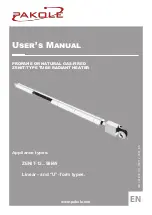
11
EN
Operating manual – gas heater fan TGH 10 E / TGH 15 E / TGH 30 E
Info
If you experience difficulties in lighting the torch, check
the air current.
Make sure that the fan is not blocked.
Make sure that air inlet and outlet are not obstructed.
If you use the device for an extended period of time, excessive
evaporation may cause a fine film to settle on the gas cylinder.
Info
Never direct the air outlet towards the gas cylinder!
Do not position the gas cylinder in front of the device!
Risk of fire and explosion!
1. Replace the gas cylinder with a new one or use a larger
gas cylinder.
Using the device as fan
You may also use the device as a fan for air circulation.
1. Make sure that the device is not connected to the gas
supply. The gas connection is rendered redundant during
the ventilation operation.
2. Remove the gas hose as appropriate.
3. Switch on the fan by setting the on/off switch (2) to
position
I
.
ð
The device now operates as fan.
Shutdown
1. Tightly close the valve at the gas cylinder.
ð
The flame goes out after a little while.
2. Keep the fan running for 3 minutes before switching the
device off.
3. Set the on/off switch (2) to position
0
.
4. Hold onto the mains plug while pulling the power cable out
of the mains socket.
5. Allow the device to cool down completely.
6. Disconnect the pressure reducer from the gas cylinder.
7. Loosen the hose connections at device and pressure
reducer.
8. Clean the device according to the Maintenance chapter.
9. Store the device according to the Storage chapter.
Errors and faults
Warning of electrical voltage
Tasks which require the housing to be opened
must only be carried out by authorised specialist
companies or by Trotec.
The device has been checked for proper functioning several
times during production. If malfunctions occur nonetheless,
check the device according to the following list.
The fan does not start:
•
Check whether the device is switched on. The on/off
switch (2) should be set to
I
.
•
Check the power connection.
•
Check the power cable and mains plug for damages.
•
Check the on-site fusing.
•
Check whether the overheating protection has tripped, see
chapter Safety.
•
The fan motor might be defective. Have a defective fan
motor replaced by a specialist electrical company.
•
There might be a fault in the circuitry. Have the electrical
system checked by a specialist electrical company.
The fan is running, but the gas fails to ignite:
•
Check whether the device is switched on.
•
Check whether the connection line is properly connected.
•
Make sure that the valve at the gas cylinder is open.
•
Perhaps the gas cylinder is empty and needs to be
replaced.
•
The ignition electrode may be dirty or positioned
incorrectly. Have a specialist electrical company check the
ignition electrode.
The fan is running, the gas is ignited, but the flame dies
after a little while:
•
Check whether the gas hose is properly connected.
•
Perhaps the gas cylinder is empty and needs to be
replaced.
•
There might be a defect at the sensors or another part of
the circuitry. Have the electrical system checked by a
specialist electrical company.
Summary of Contents for TGH 10 E
Page 16: ......



































